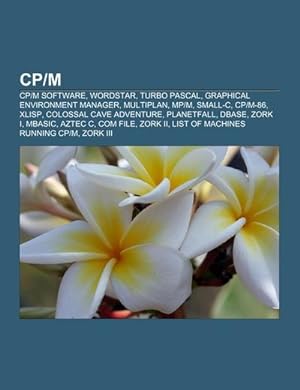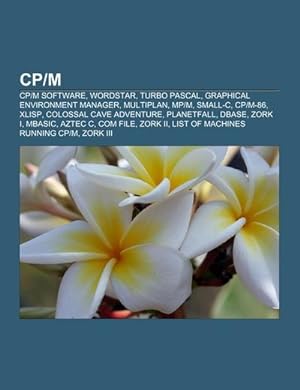9781156041970 (2 risultati)
Tipo di articolo
- Tutti gli articoli
- Libri (2)
- Riviste e Giornali
- Fumetti
- Spartiti
- Arte, Stampe e Poster
- Fotografie
- Mappe
-
Manoscritti e
Collezionismo cartaceo
Condizioni
- Tutte
- Nuovi
- Antichi o usati
Legatura
- Tutte
- Rilegato
- Brossura
Ulteriori caratteristiche
- Prima edizione
- Copia autografata
- Sovraccoperta
- Con foto
- No print on demand
Paese del venditore
Valutazione venditore
-
CP/M
Editore: Reference Series Books LLC Jan 2012, 2012
ISBN 10: 115604197XISBN 13: 9781156041970
Da: BuchWeltWeit Ludwig Meier e.K., Bergisch Gladbach, Germania
Libro Print on Demand
Taschenbuch. Condizione: Neu. This item is printed on demand - it takes 3-4 days longer - Neuware -Source: Wikipedia. Pages: 45. Chapters: CP/M software, WordStar, Turbo Pascal, Graphical Environment Manager, Multiplan, MP/M, Small-C, CP/M-86, XLISP, Colossal Cave Adventure, Planetfall, DBase, Zork I, MBASIC, Aztec C, COM file, Zork II, List of machines running CP/M, Zork III, Deadline, TurboDOS, DOS Plus, Enchanter, MSX-DOS, Sorcerer, SBASIC, Electric Pencil, Mallard BASIC, BDS C, Tatung Einstein, Peripheral Interchange Program, Zero page, ZBasic, CBASIC, JRT, Magic Wand, Pascal/MT+, SuperCalc, CPMulator, Intertec Superbrain, Ladder, MuMATH, SQ, NUL:, CMD file, Bondwell-2, IMDOS. Excerpt: CP/M (Control Program for Microcomputers) is an operating system originally created for Intel 8080/85 based microcomputers by Gary Kildall of Digital Research, Inc. Initially confined to single-tasking on 8-bit processors and no more than 64 kilobytes of memory, later versions of CP/M added multi-user variations, and were migrated to 16-bit processors. The combination of CP/M and S-100 bus computers patterned on the MITS Altair was an early 'industry standard' for microcomputers, and this computer platform was widely used in business through the late 1970s and into the mid-1980s. By greatly reducing the amount of programming required to install an application on a new manufacturer's computer, CP/M increased the market size for both hardware and software. A minimal 8-bit CP/M system would contain the following components: The only hardware system that CP/M, as sold by Digital Research, would support was the Intel 8080 Development System. Manufacturers of CP/M compatible systems customized portions of the operating system for their own combination of installed memory, disk drives, and console devices. CP/M would also run on systems based on the Zilog Z80 processor since the Z80 was able to execute 8080 code. While the Digital Research distributed core of CP/M (BDOS, CCP, core transient commands; see below) did not use any of the Z80-specific instructions, many Z80 based systems used Z80 code in the system specific BIOS, and many applications were dedicated to Z80 based CP/M machines. On most machines the 'bootstrap' was a minimal bootloader in ROM; for others, this bootstrap had to be entered into memory using front panel controls each time the system was started. CP/M used the 7-bit ASCII set. The other 128 characters made possible by the 8-bit byte were not standardized. For example, one Kaypro used them for Greek characters, and Osborne machines used the 8th bit set to indicate an underlined character. International CP/M systems most commonly used the ISO 646 norm 46 pp. Englisch.
-
CP/M : CP/M software, WordStar, Turbo Pascal, Graphical Environment Manager, Multiplan, MP/M, Small-C, CP/M-86, XLISP, Colossal Cave Adventure, Planetfall, DBase, Zork I, MBASIC, Aztec C, COM file, Zork II, List of machines running CP/M
Editore: Books LLC, Reference Series
ISBN 10: 115604197XISBN 13: 9781156041970
Da: AHA-BUCH GmbH, Einbeck, Germania
Libro Print on Demand
Taschenbuch. Condizione: Neu. nach der Bestellung gedruckt Neuware - Printed after ordering - Source: Wikipedia. Pages: 45. Chapters: CP/M software, WordStar, Turbo Pascal, Graphical Environment Manager, Multiplan, MP/M, Small-C, CP/M-86, XLISP, Colossal Cave Adventure, Planetfall, DBase, Zork I, MBASIC, Aztec C, COM file, Zork II, List of machines running CP/M, Zork III, Deadline, TurboDOS, DOS Plus, Enchanter, MSX-DOS, Sorcerer, SBASIC, Electric Pencil, Mallard BASIC, BDS C, Tatung Einstein, Peripheral Interchange Program, Zero page, ZBasic, CBASIC, JRT, Magic Wand, Pascal/MT+, SuperCalc, CPMulator, Intertec Superbrain, Ladder, MuMATH, SQ, NUL:, CMD file, Bondwell-2, IMDOS. Excerpt: CP/M (Control Program for Microcomputers) is an operating system originally created for Intel 8080/85 based microcomputers by Gary Kildall of Digital Research, Inc. Initially confined to single-tasking on 8-bit processors and no more than 64 kilobytes of memory, later versions of CP/M added multi-user variations, and were migrated to 16-bit processors. The combination of CP/M and S-100 bus computers patterned on the MITS Altair was an early 'industry standard' for microcomputers, and this computer platform was widely used in business through the late 1970s and into the mid-1980s. By greatly reducing the amount of programming required to install an application on a new manufacturer's computer, CP/M increased the market size for both hardware and software. A minimal 8-bit CP/M system would contain the following components: The only hardware system that CP/M, as sold by Digital Research, would support was the Intel 8080 Development System. Manufacturers of CP/M compatible systems customized portions of the operating system for their own combination of installed memory, disk drives, and console devices. CP/M would also run on systems based on the Zilog Z80 processor since the Z80 was able to execute 8080 code. While the Digital Research distributed core of CP/M (BDOS, CCP, core transient commands; see below) did not use any of the Z80-specific instructions, many Z80 based systems used Z80 code in the system specific BIOS, and many applications were dedicated to Z80 based CP/M machines. On most machines the 'bootstrap' was a minimal bootloader in ROM; for others, this bootstrap had to be entered into memory using front panel controls each time the system was started. CP/M used the 7-bit ASCII set. The other 128 characters made possible by the 8-bit byte were not standardized. For example, one Kaypro used them for Greek characters, and Osborne machines used the 8th bit set to indicate an underlined character. International CP/M systems most commonly used the ISO 646 norm.



